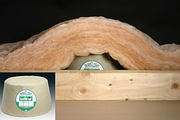1. i want my conservatory to be right and 2. i'm curious about the heat that downlights give off.
Halogen downlights get hot. Very hot, enough to burn things such as your fingers, paper, timber and other debris commonly found in lofts and similar places.
Fire hoods are cloth-like bags or cones which are placed over the top of downlighters. This means that access from above is required to fit them properly.
Their purpose is that if a fire occurred in the room below, they expand into a non combustible char, which will seal the downlighter holes. This will prevent fire spreading into the room above for a certain amount of time.
Fire rated downlights are those which are partially enclosed on the back, usually with a metal cannister, and contain similar materials to the fire hoods which expand to fill any holes when there is a fire.
Both fire rated downlights and other types with fire hoods are still capable of causing fires when incorrectly installed, and they will easily discolour or melt ceilings made of timber or plastic.
Fire rated downlights or hoods are only needed where the ceiling forms part of a fire compartment. In almost all domestic situations, this will NOT be the case. One exception would be the ceiling of an integral garage, however it isn't too likely that downlights would be fitted in there. Another example would be in a block of flats, however these would normally have concrete slabs for the ceiling, so downlights couldn't be fitted anyway.
F-marked items (those with an inverted triangle containing the letter F) are those which can be mounted on a normally flammable surface. They will have been designed in such a way that the parts in contact with the ceiling won't get hot enough to cause a fire. They may still get hot, and might cause discolouration of some surfaces.
Where the triangle has a line above it, this indicates insulation can be placed over the fitting without causing a fire.
If there is no symbol, or the symbol is crossed out, it can only be mounted on non-combustible surfaces and must not be covered with insulation. This applies to a majority of halogen downlights.
Leaving big gaps in the insulation is no good either, as this will contravene other parts of the Building Regulations.
Another significant issue with downlighters when fitted in rooms with an unheated loft space above is that the hole will provide a route for warm air from the building to enter the cold loft space. This results in condensation in the loft and leads to mould and rot.
This is prevented by either using the loftcap, or constructing a sealed box around the back of the downlight. Sealed being the important part - otherwise air will still enter the loft space. For this reason, items such as flower pots or those metal loft braces are useless, since they do not provide any kind of seal.



